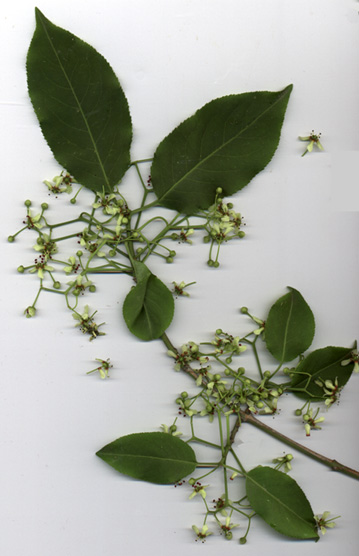| The Spindle Tree is a shrub usually, but can become very large, and is sometimes pruned into tree shape. Therefore, if space permits it likely will be featured in the forthcoming edition of my book Trees of Seattle. The first edition merely gave it brief mention in an appendix called Shrubs that can be Trees. |
| The genus Euonymus consists more than 170 species of shrubs, vines and trees, deciduous or evergreen. Euonymus (also spelled Evonymus) is an ancient Greek name, from eu, good or well, and onoma, a name; literally of good repute: well-named --used ironically because the shrubs had the reputation of stinking, and poisoning cattle. |
| Our featured species is E. europæus, from Europe, SW Asia, and the Caucasus. It is cultivated in North America and reseeds in some locales, including Seattle. It is quaint, cold hardy, slow growing, shade tolerant, long suffering, and long lived. It thrives in alkaline soil. But though cheerfully attractive in autumn, it is otherwise not beautiful, being a truly spindly and irregularly tangled shrub-tree with an intricately twisted crown usually broader than tall. Its wood is close grained, light colored, tough, and useful for little things such as charcoal pencils or violin bows. |
| Its twigs are a dull gray-green color. The flowers, produced from late April into June, are inconspicuous pale greenish-yellow. Leaves borne in opposite pairs measure 1 to 3.5 inches long; in late fall they color burnt orange or red to dark purplish and serve as a backdrop for the prettiest part of the tree: the fruit. The fruit is a decorative bumpy seed-capsule: pink-red, bursting open in fall to reveal colorful poisonous bright orange seeds. Isolated specimens bear less fruit, so for effective displays several specimens should be planted. |
| Names for this species are interesting. Common or European spindletree. European burning-bush. Skewer wood. Prick timber or Prick wood (used to make toothpicks and skewers). Dogwood (a decoction of leaves was used to wash dogs to free them from lice and ticks). Gatteridge tree (derived from a Saxon word signifying a cover --from the capsule hanging, like a cover, over the fruit). Louse berry (because the powdered leaves and berries were put on the heads of children to chase away lice). Cat tree (said to smell like a tomcat). In parts of continental Europe the colorful fruit is called pejoratively by protestants "Cardinal's Bonnet" or "Priest's Cap." |
In the southeastern U.S. the seed-capsules of a related species are called "Hearts a-bustin' (with love)."
|
Cultivars include:
|
'Albus' (fruits white)
|
'Aldenhamensis' (fruit large, bright pink and long stemmed)
|
'Atropurpureus' (purple leaves; scarlet to red fall color; fruits dark red)
|
'Atrorubens' (fruit dark carmine-red)
|
'Aucubifolius' (leaves blotched yellow, many almost wholly whitish, then pinkening in fall)
|
'Red Ace' (superior fall leaf color and rosy-red fruits)
|
'Red Cap' ('Red Caps') (fruits more heavily than usual, and fruit of deeper red color)
|
'Red Cascade' (fruit deep colored, borne abundantly even by plants in isolation)
|
'Variegatus' (several clones have been sold under this name)
|
| As for its treehood and sizes, the tallest I have measured in Seattle is taller than any I have read about elsewhere: 39 feet tall, at Woodland Park Zoo. It is one of 5 specimens on the west border of the Family Farm; its trunk is only 2 feet 6.5 inches in circumference, but it owes its great height to competition and support from adjacent spruces and cypress trees. |
| Specimens more than 30 feet tall have also been measured in Europe. The largest trunk I have read about was 4 feet 10 inches in circumference on a tree 35 feet tall in Forfarshire, Scotland (about 1836). The widest-crowned or broadest specimen reported may be one 37 feet across (27 feet tall) in Wayne County, Michigan (1978). In 1992 at Seattle's Roanoke Park I measured a tree 18 feet tall, its trunk 3 feet 10 inches in circumference, its branch spread 31 feet. That tree is now essentially lying down, only 14.5 feet tall, and its trunk cannot be remeasured. |
| It is worth pointing out that the scan I show below, is of Euonymus Hamiltonianus Wallich. This species is related very closely to E. europæus, and has been called a mere variety, but grows from the Himalayas into east Asia, bears purple (not yellow) anthers, its leaves average larger, it blooms a bit later, and it likely grows larger on average, too. There are three at Seattle's Kubota Gardens Park, the tallest 24 feet, the stoutest trunk 3 feet 9.5 inches in circumference. Seattle's Washington Park Arboretum, east of its pinetum, has 8 on the slope (with 5 E. europæus). I have not measured these yet, but some are taller than the Kubota Gardens trees. The arboretum also has other treelike species of Euonymus. |
If you know of any treelike spindle trees in Seattle, especially rarer East Asian species (such as E. myrianthus), please provide details to me so I can consider them for mention in the book. Thank you.
Back |

Euonymus Hamiltonianus scan by ALJ
|

